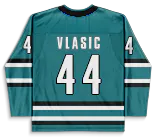Vlasic has not played since December 7th, sitting out the last four games, but will return to the lineup against the Los Angeles Kings on Tuesday. Calen Addison (undisclosed) will come out of the lineup.

Vlasic has not played since December 7th, sitting out the last four games, but will return to the lineup against the Los Angeles Kings on Tuesday. Calen Addison (undisclosed) will come out of the lineup.

Duclair was a healthy scratch in the Sharks' 6-2 loss to the Colorado Avalanche on Sunday but will return to the lineup Tuesday night against the Los Angeles Kings. Duclair has played predominantly with Mikael Granlund and Fabian Zetterlund, scoring 11 points (6G / 5A) in 27 games this season.

Andrei Kuzmenko will be a healthy scratch on Tuesday, allowing Di Giuseppe to return to the lineup. Di Giuseppe has eight points (3G / 5A), 17 penalty minutes, and 42 hits while averaging 13:35 time-on-ice through 29 games this season.

After being a healthy scratch at the end of November, Kuzmenko played 10 consecutive games but will again be a healthy scratch on Tuesday against the Nashville Predators. In those 10 games, Kuzmenko has three points (3G / 0A) and is averaging only 13:53 time-on-ice, a significant drop from the 15:24 he was averaging in the 19 games leading up to then.

Cole Guttman will be a healthy scratch on Tuesday, allowing Entwistle to return to the lineup after missing two games due to an illness. Entwistle has five points (2G / 3A) in 21 games this season while playing predominantly on the fourth line with Reese Johnson and Ryan Donato.

Johnson has only played five of nine games for the Sabres in December, scoring zero points, four shots, and two hits. He will return to his familiar spot in the press box on Tuesday as a healthy scratch.

Korchinskin has not played since December 7th, missing five games while tending to personal matters. The seventh overall pick of the Blackhawks in the 2022 NHL Entry Draft has seven points (2G / 5A) while averaging 19:31 time-on-ice in his rookie season.

Brodie did not play on Saturday due to an illness but will return to the lineup on Tuesday against the New York Rangers after participating in morning skate. Brodie has six points (0G / 6A), 16 hits, 66 blocks, and is averaging 22:15 time-on-ice, his highest total since joining the Maple Leafs in the 2020-21 season.

Colin Miller will watch the game from the press box as a healthy scratch on Tuesday, allowing Brendan Smith to draw back into the lineup. Miller has played all 15 games for the Devils this season since making his debut on November 16th, tallying one point (0G / 1A), 10 blocks, and 18 hits while averaging 14:52 time-on-ice.

Smith will return to the lineup for the Devils as Colin Miller will be a healthy scratch. Smith has played only one of the last eight games for the Devils and has two points (0G / 2A), 36 hits, and 19 blocks while averaging 14:26 time-on-ice through 22 games.

Groulx will be the odd-man out on Monday as Leo Carlsson draws back into the Ducks' lineup. Groulx has no goals and just one assist in 20 games this season.

Carlsson sat out Sunday's game in New Jersey as the Ducks continue to take a cautious approach with his workload and avoid playing him on back-to-back nights. The 2023 second-overall pick has eight goals and six assists across the first 21 games of his NHL career.

Holl will return to the Red Wings' lineup on Monday after sitting out Saturday's game in Philadelphia. The former Maple Leaf has zero goals and three assists across 22 games in his first season as a Red Wing.

After playing in each of Detroit's last five games, Maatta will take a seat on Monday in favour of Justin Holl. Maatta has no goals and five assists in 25 games with the Red Wings this season.

Lettieri will be a surprise addition to the Wild lineup after Mats Zuccarello was announced as a late scratch for Monday's game. Lettieri last played on November 30th and has just two goals and one assist in 13 games this season.

Gibson allowed one goal on 19 shots before leaving Sunday's win in New Jersey due to dehydration. Lukas Dostal stopped all 10 shots that he faced in relief. The Ducks recalled Calle Clang from the San Diego Gulls (AHL) on Monday to serve as the backup for Lukas Dostal, as Gibson will be away from the team to attend the birth of his child.

Tarasenko was a late scratch on Friday and subsequently did not play on Sunday as he tended to family matters away from the team. He was back at practice on Monday and will likely return to the lineup on Tuesday against the Arizona Coyotes. After averaging only 1.4 shot per game during a seven-game stretch with three points (0G / 3A), Tarasenko has been more involved lately, seeing his ice-time increase by 97 seconds per game, scoring six points (3G / 3A) and averaging 3.1 shots in seven games.


Hanley has semi-regularly been in the Stars lineup lately and will draw back in on Monday in favour of Nils Lundkvist. Through nine games this season, Hanley has one point (0G / 1A), eight hits, and seven blocks while averaging 12:44 time-on-ice.

Faksa will be a healthy scratch on Monday against the Seattle Kraken, allowing Craig Smith to draw back into the lineup. Faksa has six points (2G / 4A) in 25 games this season and is only averaging 12:59 time-on-ice, his lowest total since his 2015-16 rookie season.
